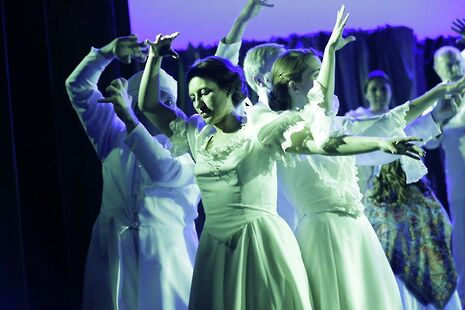The Secret Garden
Genevieve Cox is dumbfounded by this haunting half-term treat

“Ghosts only exist as long as someone on earth remembers them…..” This performance will retain a similarly ghostly presence in its haunting quality, which stays with the audience long after the final song. It is a brilliant reincarnation of Frances Hodgson Burnett’s The Secret Garden by Marsha Norman and Lucy Simon, performed beautifully at the ADC by the Festival Players.
A sense of haunting was prevalent throughout. From the opening scene, themes of death were instigated and perpetuated in the chorus of ghosts who, dressed in white and singing in unison, remained throughout the rest of the performance as a parallel plot, omnipresent in their deathly, surreal existence beyond the ‘real’ world of the present upon the stage. This motif was continued through beautifully archaic singing, musical leitmotifs, images and verbal puns – notably upon the names. The musical score was manipulated such that the nursery rhyme ‘Mary, Mary, quite contrary’ was a constant, echoing presence, hinting by the mention of the dead flowers in the nursery rhyme at the deaths of the mother, Rose, and aunt, Lily. This use of punning throughout the play set up doubles in the music, in the echoic atmosphere, and in the repetition of songs, which collectively created a haunting ambience.
Staging was used to physically emphasise the dual worlds of living and dead, presented upon two platforms of differing height. Yet, not only was a dual world set up between the dead and the living but the management and direction drew out the many parallels present in the original novel: those of India and England, the young and the old, the worlds of servant and master, the inside and the outdoors, the known and the unknown, the two children’s disparate yet quintessentially similar lives, and the character pairings of the brother and sister (Dickens and Martha) and the two brothers (Archibald and Dr Neville).This doubling worked on two levels – to produce simple binaries for the child viewer and to offer insight for the adult viewer, making the play appropriate for an audience of diverse ages.
India and England were intermingled in the behaviour of the protagonist, Mary Lennox, who brilliantly characterised the adaption from Indian to English customs in her transformation, with a change of clothes correlating to a change of character, attitude and intentions. Parallel to Mary’s linear character progression was the physical improvement of her cousin, the psychological release of her uncle, the revelation of Dr Neville’s evil, and the development of individual and universal friendships and union. An overarching coming to terms with grief and letting go of the past in order to live in the present combines with a letting go of India to live in England, and a letting go of physical and emotional barriers to live in freedom.
Overall, this was a fulfilment of fairy-tale conventions of a children’s story, performed poignantly – yet with moments of humour – upon the ADC stage. Musical elements did enable adult appreciation yet the play ultimately adhered to its target audience of children. But it should definitely appeal to a diverse audience and will be a perfect performance for a ‘half-term treat’.
 News / Clare Hall spent over £500k opposing busway 24 December 2025
News / Clare Hall spent over £500k opposing busway 24 December 2025 Comment / The ‘class’ of Cambridge24 December 2025
Comment / The ‘class’ of Cambridge24 December 2025 News / Caius mourns its tree-mendous loss23 December 2025
News / Caius mourns its tree-mendous loss23 December 2025 Comment / League tables do more harm than good26 December 2025
Comment / League tables do more harm than good26 December 2025 News / Girton JCR publishes open letter expressing solidarity with Palestine25 December 2025
News / Girton JCR publishes open letter expressing solidarity with Palestine25 December 2025








